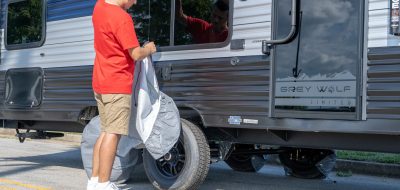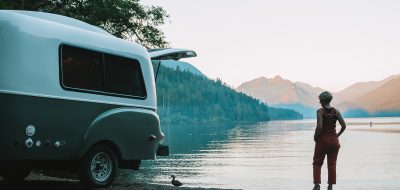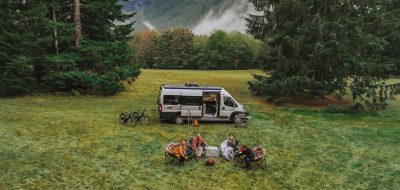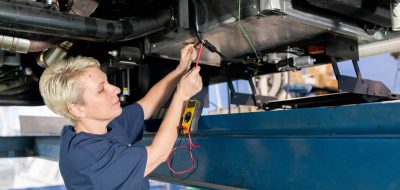Courtesy of Good Sam Extended Service Plan
For those of us who have put our RVs into hibernation over the winter months, spring is an exciting time because — as Willie Nelson so appropriately sang — we “just can’t wait to get on the road again.”
Ideally, we did a stellar job preparing our RVs systems of winter storage, ensuring that the de-winterization process will be simple. However, since we are all human, it’s possible to have skipped a step or worse — skipped the winterization process altogether. This means preparing your rig for spring travel may take additional work — even perhaps fixing some damage.
Here are some quick steps to help evaluate how your RV weathered the winter:
- First Look: Inspect inside the coach for water leaks — ceiling or paneling stains — and animal infestation. Even if no water leakage is evident, check the roof for areas where the sealant may have shrunk around vents and other seams. Once you have thoroughly checked for leaks and none are evident, wash and wax your RV. You may also want to apply a petroleum distillate-free protectant in areas including rubber roofs, tires, moldings, and plastics.
- Freshwater System: If you used non-toxic RV antifreeze, drain it as thoroughly as possible via low-point drains, the water heater drain, and tank drains. Return the water-heater bypass to the operational position, and flush the system thoroughly with fresh water via the water pump and the city water connection.
- Electrical Systems and Appliances: If the batteries have been on a converter or trickle charger, they should be ready for the road. To be safe, just check electrolyte levels (if applicable) and make sure there’s no corrosion on the battery connectors. If everything looks good, connect the shore power cord, and operate all appliances — use a 30-amp (or higher) service to test the A/C. Next, use a polarity checker to ensure all wall outlets are functional.
- LP-gas: After prolonged storage with the LP-gas supply turned off, the gas lines will be full of air. To purge, open the LP-gas tank or cylinder service valve, then light a stove burner (this may require you to hold a flame next to the burner up to 30 seconds as air escapes). With the burner flame continuing, turn the refrigerator to gas, and check to ensure the flame is lit. Repeat this for the water heater and furnace. If you suspect a leak in the lines, you can use wipe soapy water over the lines to confirm — bubbles will form where leaks exist for easy detection.
- Running Gear: During storage, tires gradually lose inflation. Re-inflate to prescribed levels for safe travel — when in doubt use the pressure value listed on the tire sidewall. Motorhome owners may opt to inflate tires according to load/inflation tables, when such figures are available. This approach may improve ride quality, and must be used with accurate weight figures for safe travel. You may also want to add 10 psi as a safety margin.
Hopefully, this evaluation shows you that your RV has survived the winter with no major damage. But in case you’ve stumbled upon some minor repairs needs, we at Good Sam Club have a slew of tech tips from industry experts and other Do-It-Yourselfers to help you through small jobs. Another great benefit of being a Good Sam Club member is access to the Good Sam Extended Service Plan. For those repairs you can’t tackle yourself, Good Sam ESP is a mechanical breakdown insurance that protects you whether you’re at home or hundreds of miles away.






Nancy
We use Quick ‘n Brite in our RV as well. It is the best product you will find to remove bugs and black streaks from the outside of our RV. We just bought a refill container of Quick n Brite at the Good Sam Rally in Phoenix this past month and are constantly sharing it with our RVing friends. I was also talking to the sales representative and he said they are looking for new representatives, especially RVing couples that travel to all the Rallys. I got their phone number off our bucket if anyone is interested in trying it or becoming a sales representative: 425-778-8285
Nicole
My husband and I use Quick n Brite every year when we de-winterize our coach. We try and air it out throughout the winter months when it doesn’t get much use but that is sometimes easier said than done so we go in with our Quick n Brite and clean EVERYTHING from floor to ceiling. It’s an all purpose cleaner so the same solution can be used on carpets, counters, windows, toilet (its a great deodorizer and far cheaper than the blue stuff). We also use it to prevent the inside windows from fogging up! It’s handy to use on the road because we only need to store one cleaner under the sink instead of piles of them for different uses. We purchased our Quick n Brite at an FMCA rally for the first time but have since then purchased it online at http://www.quicknbrite.com
Would recommend QUICK N BRITE to and RVers for “spring cleaning” the coach